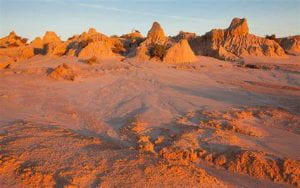Easter is almost here, so Happy Easter everyone! Although we could talk about Easter traditions or Jesus’ tomb , we are instead going to talk about putting people back into tombs. Well actually they are unmarked graves in anonymous locations. I am talking about the recent announcement by the Australian government that the ancient remains of 108 Aboriginal people found in Lake Mungo and Willandra Lakes throughout the 1960s-80s, the oldest having died around 42,000 years ago, will be reburied in 26 unknown locations throughout the Mungo National Park, part of the Willandra world heritage area, in Australia. Among these remains are the well-known Mungo Man and Mungo Lady.
In 1967, geologist Jim Bowler was exploring the lunette (a wind-formed, crescent-shaped dune composed of clay, silt, and sand that occurs on the downwind margins of ephemeral lakes) of the now dry Lake Mungo, observing its ancient layers of sediment. After he returned in 1968, he noticed what appeared to be burnt bones, and returned the next year with archaeologists John Mulvaney and Rhys Jones to uncover Mungo Lady. In 1974, Jim Bowler was continuing his geological studies when he again stumbled upon a white object in the soil, which turned out to be the cranium of the remains that would be called Mungo Man.
Mungo Man and Mungo Lady are among of the oldest anatomically modern human (Homo sapiens) remains found outside of Africa, dating to around 42,000 years ago. Mungo Man was a 1.7m tall hunter-gatherer who lost his two lower canine teeth when he was young and had worn out molar teeth due to his diet. He developed arthritis as he grew older, especially in his right elbow, most likely caused by throwing spears with a woomera (a wooden Australian Aboriginal spear-throwing device, similar to an atlatl) often, and he died at around age 50. His burial ritual is the oldest known example in the world; buried in a lunette, on his back, hands crossed in his lap, with red ochre sprinkled over him. Mungo Lady’s burial is the oldest known cremation in the world. After cremation, her remaining bones were crushed, burned for a second time, and then buried in an expanding lunette. The burials are some of the world’s oldest evidence of ritual cremation and ceremonial burials, again emphasizing the importance of these remains as extremely valuable finds.
After extensive negotiations with Aborigional Elders from three traditional tribal groups of the area, the Paakantji, the Ngyiampaa, and the Mutthi Mutthi, Mungo Lady was returned to Lake Mungo in 1992 after being studied at the Australian National University. However, she remains locked in a safe at the Mungo National Park, awaiting reburied as a keeping place has not been reconstructed due to erosion of the lunette. One key to the safe is kept by scientists, the other by the Elders. Mungo Man was also kept at the Australian National University, before being repatriated and returned to Mungo National Park in 2017. In 2018 it was announced by the Australian government that both Mungo Lady and Mungo Man, along with the ancestral remains of 106 people that have been found in the Lake Mungo and Willandra Lakes areas, will be reburied. This proclamation was finally officially approved by the government on April 6th, with the remains to be buried in 26 unmarked sites near and in the Mungo National Park. The remains will be monitored and secure, and their locations will only be known by a select few people belonging to the Aboriginal Advisory Group (AAG).
While this does seem like good news, and the Australian government claims that this is what the local Aboriginal community wants, it has been stated that some locals and descendants of the remains have expressed disappointment in not being consulted and that more input from the Aboriginal community is still needed. Some local Aboriginal peoples feel excluded from the process and some state that they desire not only a reburial but a ceremonial place of significance for the remains. However, it does appear that the proper channels have been taken, as the decision is supported by the AAG. The Willandra Lakes Regional World Heritage Area AAG expressed their desire for reburial in 2018, and today the chairwoman and Mutthi Mutthi elder, Pasty Winch, has expressed that the government has listened to her people. This recent decision is an important move forward for peoples and cultures around the world who wish for the repatriation and burial of ancestral remains.
Follow IUP Anthropology on Facebook, Twitter, and Instagram
Further Reading

